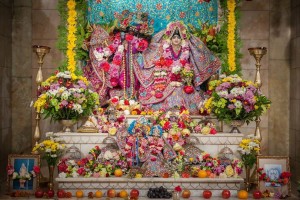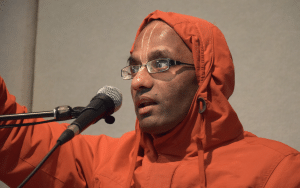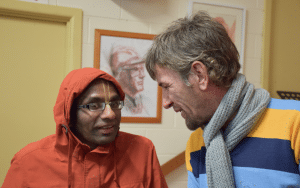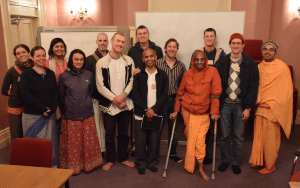The post Daily Darshan – June 19th, 2015 appeared first on Mayapur.com.
Daily Darshan – June 19th, 2015
15.06.2015 H.G. Banabhatta Prabhu_SB-5.24.23-24
→ Gouranga TV - The Hare Krishna video collection
15.06.2015 H.G. Banabhatta Prabhu_SB-5.24.23-24
An Inevitable Occasion
→ Seed of Devotion
Inevitably, that day will come.
All that mattered was the holy name. I felt so loved unconditionally. Even though all of these offenses that can be committed to the holy name are there in my heart, somehow none of them mattered at the time of death. NONE of them. None. Krishna was there for me. It was an amazing experience how the holy name was all that existed and I felt safe.
I had no idea what was coming next, but that was okay. I felt no fear. I felt so loved, that was the surprising thing. No matter what I'd done or said or in my life, Krishna's holy name was there. If at my time of death I can chant the holy name, then my life is complete.
And if I can't chant, the holy name will come for me.
“My dear Lord Krishna, how will it be possible for me to remember You at the time of death, when my throat will be choked up with mucus, bile, and air? O my Lord, may I leave this world at this very moment when I am healthy and conscious; let the royal swan of my mind enter the tangled stems of the lotus of Your feet." - Prayers by King Kulashekhara
How can I serve with someone who doesn’t like me?
→ The Spiritual Scientist
Answer Podcast:
World Yoga Day – Let’s Go Beyond Political and Physical Posturing
→ The Spiritual Scientist
The United Nations General Assembly in accordance with the call of the Indian Prime Minister, Narendra Modi, is celebrating World Yoga Day on June 21. This is the day of the Summer Solstice, the longest day in the Northern Hemisphere and a day considered significant in many traditions. The fact that scores of countries all over the world, including many Islamic countries, are observing the day is testimony to yoga’s universality.
Unfortunately, in India, this occasion has got caught in an unnecessary controversy. Some groups have alleged that the promotion of yoga is an attempt to covertly impose a Hindu practice on India, thereby threatening the country’s secular fabric. This allegation originates from an inability to separate the specific origin of a thing from its universal purpose. Consider a scientific thought-system such as classical physics. It began in Britain with an English scientist Isaac Newton, but has now become a part of the common human intellectual heritage whereby its insights and applications are accessible for everyone everywhere. Acknowledging that classical physics originated in Britain doesn’t amount to promoting Anglican colonialist nationalism.
Similarly, yoga originated in India, but it has now become a part of the common human wisdom-heritage. Acknowledging that yoga originated in India in the traditions from which Hinduism originated doesn’t amount to promoting right-wing Indian nationalism. To misrepresent yoga for scoring political brownie points is to distressingly devalue yoga.
While yoga is devalued by political posturing in India, in the West it is devalued by physical posturing–it is reduced to an exercise for treating and shaping the body. However, at its core, yoga is a time-tested process for experiencing our universal spiritual essence and harmonizing with it–a harmonization that can bring physical improvement as a side-benefit. Within the spiritual process of yoga, as outlined in Patanjali’s classic treatise, the Yoga-Sutra, physical postures, called asanas, are the third among the eight limbs of yoga. For a cricketer, standing in a posture is not an end in itself; it is a means for hitting the ball well. Similarly, the asanas in yoga are not ends in themselves; they are launching pads for catapulting human consciousness on a spiritual journey.
This deeper purpose of yoga is conveyed by ancient yoga texts through the various definitions they give of yoga: for example, “sense control” (Katha Upanishad), “mental control” (Yoga-sutra), “skill in action” (Bhagavad Gita), “union between the individual self and the Supreme Self ” (Yoga Yajñavalkya). Significantly, none of them equate yoga with postures alone–to the contrary, the Hatha Yoga Pradipika (4.79) categorically declares that practicing asanas without striving for mind control is not yoga practice at all. The semantic and conceptual alienation of yoga from its original meaning is similar to the straying of the meaning of the English word ‘lady.’ It stems from the Middle English lavedi, which comes from the Old English hlaefdige “kneader of dough.” In contemporary Western usage, kneading dough is the work of servants, not ladies.
Perhaps the meaning of “yoga” that best reflects its universality is its standard dictionary meaning: connection. Yoga enables us to connect with our spiritual side, to experience our spiritual connectedness as parts of the same spiritual tree, to rejoice in our shared spiritual purpose: to love and to be loved. The Bhagavad-gita (06.46) declares intrepid yogis as the best among all human beings, and further deems (06.47) as consummate those yogis who link in love the finite human consciousness and the infinite divine consciousness. Among the many ways for establishing this connection, the most efficacious is through mantra. Mantras are specialized sound vibrations that when meditated upon serve as elevators for rapidly raising our consciousness to the spiritual level.
If we strive to savor and share this yogic spirit of connectedness, we can go beyond political and physical posturing to find universal fulfillment.
On Women and Cows – Domestic Abuse
→ The Enquirer
Recently I became disgusted with the frequency and extent to which I encountered violent abuse of women even among those who we suppose also try to practice bhakti-yoga. Since I live in relative isolation from the English-speaking world, Facebook (for better or worse) is something of an outlet for me. So I made a Facebook post expressing my opinion that “A man who hits a woman is far, far worse than a man who slaughters a cow. I can think of no man more unmanly and disgusting than he who, under any but the most dire circumstances, hits a woman.”
Someone asked: “Is this something from sastra [sacred wisdom], or more your personal perspective?” The same person expressed an opinion that, “I appreciate your passionate stance against abusing women, but I’m concerned it’s at the expense of minimizing the horror of cow slaughter.”
This deserves a thorough reply.
My statement is my personal conviction, but I do not cherish personal convictions which I deem to contradict śāstra. Therefore although it is not a direct quote or paraphrase from śāstra I believe that it is “śāstric” – in that it expresses śāstric principles. I will try to explain why I feel this way.
Those who Must not be Punished
Bhāgavatam 1.14.41 is an example of śāstra stating that harmless, defenseless, non-agressive creatures must be nourished and protected, not harmed or punished. Here Emperor Yuddhiṣṭhira – son of the god of morality, Dharma – identifies those beings who fall into the category of “harmless, defenseless, and non-agressive”:
- brāhmaṇa — Those who pursue education and are self-governing
- bālaṁ — Children
- gāṁ — The BBT translation says this refers to “Cows” – let’s examine that later.
- vṛddhaṁ — The elderly
- rogiṇaṁ — The diseased (physical or mental)
- striyam — Women
- śaraṇopasṛtaṁ sattvaṁ — Any creature who needs protection
Cows Epitomize (Not Superceede) All Animals
Gām, the word translated as “cows” in the BBT edition, literally means “things that move.” The BBT Bhāgavatam translates it in various ways in the various contexts in which it appears as a noun. These translations range from “planets” to “the earth” to “the ocean.” All these are appropriate in context because gāṁ literally just means, “things that move.”
“Things that move” contrasts “things that don’t move” as a way to divide the animal kingdom from the plant kingdom. We see this concept used constantly throughout śāstra in statements like carācara (“Moving and non-moving entities”). In the current context, since Yuddhiṣṭhira is talking about entities who deserve protection, gām especially denotes the non-agressive, herbivorous animals like horses, goats, sheep, deer and cows. Of these herbivores, cows are particularly defenseless and also particularly important to agrarian society. Therefore Śrīla Prabhupāda cast the word gām as “cows” in this instance. We should understand that the cow stands for all non-agressive animals, as their epitome – not that the importance of protecting the cow excludes the importance of protecting all other herbivores or animals in general.
Indeed, to insure that we do not interpret any of the beings on this list in an exclusive manner, Yuddhiṣṭhira concludes the list by including śaraṇopasṛtaṁ sattvaṁ — any and all creatures who need or request protection.
Similarly, the concept that cows are divine shouldn’t have an exclusive tense: “Only cows are divine,” implying that other animals are not. The tense should be inclusive: “Especially cows are divine,” implying that all things are divine, especially living things, and especially cows.
Dear to Krishna
Krishna surrounds himself with cows and dwells in “go-loka” (a world of cows). Why is the cow dear to Krishna? Because she epitomizes non-agression, affection, and motherly love. We can say that the cow is the most feminine of all animals. Even more thoroughly than he is surrounded by cows, however, Krishna is surrounded by something even more feminine – beautiful young women, the gopī-lakṣṁīs. Indeed Krishna primarily dwells in this “go-loka” (a world of gopīs)!
One can examine the sequence in Śrī Brahma-saḿhitā 5.29 to verify the above.
cintāmaṇi-prakara-sadmasu – First he is surrounded by a land of conscious substance “cintāmaṇi.”
kalpa-vṛkṣa-lakṣāvṛteṣu – Within that, he is surrounded by a forest of conscious trees.
surabhir abhipālayantam – Within that forest, he is surrounded by a heard of fully-conscious divine cows.
lakṣmī-sahasra-śata-sambhrama-sevyamānaḿ – But at the center of it all he is surrounded by hundreds of thousands of lakṣmī-gopīs (women) who fulfill all his desires with utmost affectionate super-consciousness.
On this basis it is safe to conclude that divine cows are near and dear to Krishna, but divine women are even nearer and dearer. It is reasonable to apply this to the phenomenal analogue of these divine cows and women, coming to the conclusion that cows and animals are certainly near and dear to the divine, but women are even nearer and dearer.
Comparisons
The hermeneutic of comparison should also be borne in mind, please. When we say, for example, “John is taller than Joe” have we said that Joe is short? No. We haven’t actually said anything about Joe’s height. Whatever Joe’s height might be, we are saying that John is taller.
Actually, since the statement is about height, it tends to imply that Joe is fairly tall, but John is even taller.
I said that hitting a woman is worse than killing a cow. Does this mean that killing a cow is not so bad? No. In fact, since the statement is about bad things, it implies that killing a cow is very bad and beating a woman is even worse.
Gradations of Violence
Yeah, but how much worse? Is just hitting a woman worse than slaughtering a cow?
I am not sure how to weigh such things down to the milligram, but even if the recipe given in my choice of words gives too little weight to the cows, hyperbole (exaggeration) is a valid hermeneutic. To make a dramatic point, one can use hyperbole – expecting the thoughtful audience to understand, and the simple audience to be adequately impressed of the point.
Maybe I went overboard in my original wording, so I subsequently edited my statement to read like this, “A man who beats a woman is as foul as a man who slaughters a cow. I can think of no man more unmanly and disgusting than he who, under any but the most dire circumstances, beats a woman.”
This still puts more weight on violence to women, and I think it certainly deserves to be that way. All proponents of ahiṁsa admit to gradations of violence in, for example, their fundamental statements on dietary rules. All the lawmakers from Manu to modern day admit the same paradigm. For example: Worse than picking a fruit, leaf, seed or nut is killing the whole plant. Worse than killing the plant is killing an animal. Worse than killing an aggressive animal is killing a helpless, harmless animal. Worse than killing animals is killing humans. Worst of all is killing a helpless, harmless human. Worse of all is killing a beneficial human (like a brahmaṇa or guru).
Even if Yamarāja has to explain to us exactly how his scales of justice measure things, and which items weigh how much, still we can be reasonably requested by speakers such as myself not to nitpick.
And the Point is…
The point, dear friends, is that anyone who violates a woman is a most reprehensible, foul, disgusting and unmanly excuse for a creature. Even subtle abuse and exploitation is an abomination. If we commit these horrible sins, we must immediately stop, and figure out how to make amends for the incredible mountains of pain that now hover karmicly above our heads with razor sharp edges.
Vraja Kishor dās
Tagged: domestic abuse, violence
Bhagavatam-daily 242 – 11.11.48 – Association sustains devotion
→ The Spiritual Scientist
Bhagavatam daily Podcast:
Bhagavatam-daily 241 – 11.11.47 – Absorption comes from both attraction and determination
→ The Spiritual Scientist
Bhagavatam daily Podcast:
Bhagavatam-daily 240 – 11.11.46 – Specific details of Krishna’s forms are not to be transcended but to be treasured
→ The Spiritual Scientist
Bhagavatam daily Podcast:
Bhagavatam-daily 239 – 11.11.45 – See social service as a form of devotional service, not its replacement
→ The Spiritual Scientist
Bhagavatam daily Podcast:
CC daily 139 – M 6.203 – Krishna’s defining depiction reflects his loving disposition
→ The Spiritual Scientist
CC-daily Podcast:
CC daily 138 – M 6.202 – The bhakti conception of the divine is polymorphic mono-theism
→ The Spiritual Scientist
CC-daily Podcast:
CC daily 137 – M 6.201 – Self-criticism is for our disposition not our composition
→ The Spiritual Scientist
CC-daily Podcast:
CC daily 136 – M 6.200 – Pride alters our destination by distorting our vision
→ The Spiritual Scientist
CC-daily Podcast:
Please Join The Japa Group
→ Japa Group
The nature of friendship
→ KKSBlog
(Kadamba Kanana Swami, 08 March 2015, Stockholm, Sweden, Srimad Bhagavatam 3.1.4)
Transcribed by Nama-rupa dd
Question: Guru Maharaj, you mentioned that in the material world, there is no love. I am thinking about the friendship, is there friendship in this material world and what is the nature of friendship?
 Love, friendship, society, togetherness, one-for-all and all-for-one, does not exist. Kavi Karnapura describes friendship in the Caitanya Candrodaya Nataka and he points out that for friendship to exist, there is a need for certain conditions to be met.
Love, friendship, society, togetherness, one-for-all and all-for-one, does not exist. Kavi Karnapura describes friendship in the Caitanya Candrodaya Nataka and he points out that for friendship to exist, there is a need for certain conditions to be met.
First, one has to receive the mercy of the Lord so that he gets in touch with transcendental knowledge, Krsna-prasade paya bhakti-lata-bija (Caitanya Caritamrta Madhya 19.151). You have to get in contact with devotees otherwise where is there real friendship!?
Materialistic friendship is always mixed with some material motive, some personal motive so real friendship must be based on receiving the mercy of the Lord. When you receive the mercy of the Lord then you come into the association of devotees and attachment to devotees must develop, and from being in that association, gradually you evolve.
Then Kavi Karnapura explains the next level that you get – it is the level of thoughtfulness and discrimination. You begin to kind of reflect on the meaning of life and in that way, you mature as a person and you don’t just respond with outbursts and this and that. NO! You respond more thoughtfully and in a deeper way. Then you get to the non-envious platform.
After this thoughtfulness and discrimination becomes strong, in the association of devotees, then you get equanimity – a state of mind which becomes balanced. You become balanced in the mind. At that state, you can realize non-envy and it says that then you can actually be a friend. Then friendship is possible!
Kavi Karnapura explains it like that. So it is interesting; he gives conditions before real friendship can develop and to the degree that these conditions are not met, to that degree we are lacking in friendship.
Sometimes even when you are married, you wonder, “Is this person actually my friend?” You are married but you are wondering, “Are we friends? Are we at least friends? What to speak of love! I mean friends! Is this person actually my friend, through-and-through, you know, through thick and thin… Is this person really my well-wisher??”
 There are different Sanskrit definitions. Maitri is a word used which is more general. Another word that is used is suhrit, close to the heart. That gives the higher aspect, very intimate. So among vaishnavas, it must become like that.
There are different Sanskrit definitions. Maitri is a word used which is more general. Another word that is used is suhrit, close to the heart. That gives the higher aspect, very intimate. So among vaishnavas, it must become like that.
But before we can have friendships, we have to go through these stages: we need the mercy of the Lord, we need to develop attachment to serving the devotees, and we need to be with devotees in proper etiquette. Then we become thoughtful and then we get discrimination from these devotees.
In this verse (Srimad Bhagavatam 3.1.4), it says sadhu-vada, things approved by the learned circles, approved by saints and sages, so that we understand what is approved by saints and sages and then it becomes our second nature. It is happening. Like certain foodstuffs are obviously not approved by saints and sages, and we don’t even think of touching them. We don’t have to tell ourselves, it becomes a part of our second nature.
So this discrimination and thoughtfulness becomes a part of our nature, and when we have absorbed it to that extent then you have non-envy and equanimity, a balanced state of mind. Then, you can be a friend all the time!
Like that, friendship takes some time. When you are dealing with someone under the modes of nature, today he is your friend and tomorrow not so much because tomorrow he is the friend of his mind. Tomorrow he is controlled by his senses, tomorrow he is riding on the back of that inner boar and then he is maybe not your friend.
When I had a Vedic marriage, it was done by Bhavananda and he made us promise, he said to me, “You must always bring your wife to devotional service, to Krsna.” And he said to her, “But when he deviates then you become like a lion, like a tiger and you just somehow or other pull him back.” So that was something I remembered.
So friendship also means that with our weaknesses, we are still trying to help each other and that is nice but Kavi Karnapura takes it to a higher level for friendship to really flourish.
Four Vaishnava Sampradayas Will Join ISKCON to Chant For Change
→ ISKCON News

ISKCON and the spiritual leaders and members of the four bona fide Vaishnava Sampradayas are set to unite to chant the Holy Names during the international kirtan festival. The aim of the event is to bring together people from various races, faiths and nationalities to chant the Names of God, a process that is common to all faiths of the world.
Food for Life Global Moves Headquarters to Green City Capital, Ljubljana
→ ISKCON News

Today the network of affiliates expands the globe and now includes projects all over Asia, the former soviet union and many parts of Africa and South and Central America. “We are pretty much everywhere these days, although some projects are very small in comparison to our larger and more sophisticated projects in India, where it all started,” Paul Turner said.
Krishna Can Bring Good Out Of Everything – Even Our Mistakes
→ ISKCON News
Yamuna Restoration
→ ISKCON News
The Greatest Gift
→ ISKCON News
The power of Harinama Sankirtana :-)
(From a Harinama in…
→ Dandavats.com

The power of Harinama Sankirtana :-)
(From a Harinama in Chisinau, Moldova)
ISKCON Mayapur Life Style (5 min video)
Watch it here:…
→ Dandavats.com
A spiritual wonder down under (Reflections on my outreach tour to Melbourne)
→ The Spiritual Scientist
Some eight years ago my spiritual master His Holiness Radhanath Swami Maharaj told me to learn to write for a Western audience. He explained that since Indians were also getting westernized, material written for a Western audience would appeal to them too.
Since then, I have read various books written by devotee-authors for a Western audience. Then I corresponded by email with many of these devotee-authors, appreciating their works and offering to serve them as an editor for their future books. During the ensuing interactions, I got to know the story behind the story – how they came to write what they wrote. Based on the guidance of these devotees, I read many books written for a Western audience by other spiritual authors – Christians, yoga teachers, Buddhists, academic scholars of religion and post-modern thinkers – paying special attention to their choice of diction, style and content.
Finally after nearly a decade of distant preparation and at the prompting of several devotee-authors, I recognized that I needed to interact with my audience firsthand to understand them better. Accordingly, when Muralidhar Prabhu, who has long appreciated my talks and writings, and has even arranged the translation of three of my books into Chinese, invited me to come to Melbourne, I accepted the invitation.
After taking the blessings of senior devotees and offering my prayers to Their Lordships Sri Sri Radha Gopinath – “Let this trip deepen my conviction that you, O Lord, are the only ultimate substance and that everything else, no matter how attractive-looking, is eventually insubstantial” – I embarked on the tour to Melbourne from 27th May to 9th June, 2015.
A heartwarming blend of the natural and the devotional
The eighteen-hour flight with a five-hour jet lag was uneventfully pleasant. I landed at Melbourne in the early morning cold in what was the coldest part of the year on one of the southernmost parts of Australia. As we drove to the temple, I noticed that the architecture of Melbourne was a pleasing blend of the traditional and the modern. In the Melbourne ISKCON temple, the central building is the oldest building in the whole area and is a heritage building. It also contains a large devotional heritage room: The room in which Srila Prabhupada lived during his visit in 1975 has been preserved as it is.
With comforting greenery in the premises, the temple atmosphere is a heartwarming blend of the natural and the devotional. The Deities are the divinely beautiful Radha Vallabha, Jagannatha-Baldeva-Subhadra and Gaur-Nitai. By their sacred presence, they manifest in Melbourne simultaneously the three holiest abodes of Gaudiya Vaishnavism: Vrindavan, Jagannath Puri and Mayapur.
I had three illuminating meetings with the Temple President, His Grace Aniruddha Prabhu, who has been a rock of stability for the Melbourne community for the last twenty-five years. He explained the temple’s outreach strategy centered on prasad distribution. When Srila Prabhupada had come there, he had said that anyone from around ten miles should be able to come to the temple and get free prasad. Accordingly, the temple has been providing free prasad – and opulent prasad with multiple items at that – three times a day to all visitors for several decades. Additionally, through its two restaurants, the temple reaches to a significant number of Australians and creates by this gustatory outreach the human connections foundational for philosophical outreach. An ongoing kitchen expansion project will expand the outreach substantially – with the expanded kitchen, the temple will be able to start several more restaurants. The center also has a vibrant educational ethos with several Bhakti-Shastri, Bhakti-Vaibhava and Bhakti-Vedanta courses being conducted.
Cricket Metaphors
My first talk was on 28th evening at Mantra Lounge, which is a youth center close to Melbourne University. Entitled “Love is in the SOUND”, the talk attracted students from various countries. But I had to pay the price for spin-doctoring my topic. For me, SOUND was an acronym (Satisfying, Omnipotent, Universal, Non-material, Direct) that conveyed the qualities of the sound of the maha-mantra, which manifests the infinite’s love for the finite. But for the students, the topic fuelled a set of romantic and sentimental expectations that my talk obviously couldn’t fulfill. Though they heard me politely, they asked no questions and later conveyed their disappointment to the local youth coordinator who thereafter gave me candid feedback.
For most Indians – and I am no exception – the mention of Australia usually brings thoughts of cricket; India’s cricket rivalry with Australia is intense, second only to its rivalry with Pakistan. So the thought of cricket was lurking at the back of my mind right from the start of my Australian visit. As I contemplated the feedback, a cricket metaphor sprang up, leaving me shaking my head ruefully. My “international debut” had been underwhelming – though I hadn’t been dismissed for a duck, still I had run myself out before reaching double figures even. Thankfully, I had many more innings to redeem myself.
My next class was on the evening of Pandava Nirjala Ekadashi. Speaking on the Bhagavad-gita to a friendly audience of devotees was like playing on home turf. Based on the Gita 5.17, I spoke on “Overcoming obstacles at the levels of the mind, intelligence and faith” and answered several thoughtful questions.
The next class was the temple Bhagavatam class on 30th morning on a technical section of the third canto dealing with creation. I spoke on “Conceptual, conversational and chronological background of the Bhagavatam’s creation narrative” and could see a few impressed and many dazed faces in the audience. After the class, as I contemplated the future classes which would be more technical than this one, another cricket metaphor popped up in my mind and had me laughing. If I went on into the technicalities of the Bhagavatam’s division of species, I felt I would be like a batsman raising his bat to hit a sixer and finding that there was no ball, no baller, no umpire, no fielders, no spectators – just the batsman swinging the bat through the empty air on an empty ground. Few if any in the audience would be able to connect with the technicalities. I intended no disrespect to my audience’s intelligence; just that a technical analysis would require charts and powerpoints – and couldn’t be done in a Bhagavatam class. A special seminar for interested devotees doing a Bhakti Vaibhava course would be a more appropriate forum.
As I considered alternative strategies for dealing with the subject, I found myself pondering the universal human questions that the Bhagavatam’s technical presentation sought to answer. And as I contemplated the answers for those questions provided by other, more contemporary knowledge-sources, I found a way to present the topic intelligibly. During my subsequent Bhagavatam classes, I compared the scientific, Christian and Bhagavatam conceptions of the nature and purpose of creation, the possibility of extra-terrestrial life, the difference between humans and animals and the nature of time. After the classes, many devotees asked intelligent, well-informed questions, thereby demonstrating that they could connect with the analysis. I felt that this topic could well become the theme for a book (another addition to the many book dreams that I don’t know whether I will be able to actualize in this life).
A stirring spiritual experience
My second class to a Western audience was at the Urban Yoga Center on the topic of “The Anxiety Epidemic.” I spoke how overemphasis on personality (how we appear) at the expense of the person (who we actually are) is a major cause of anxiety. It was after the class that I had the most moving experience of my entire Australian visit. While I was giving the class, I was too caught in doing things – trying to present the bhakti message in the most intelligible way. But when the soothing kirtan started, the wonder of it all struck me: seeing the Western faces all around me drove home the point that I was really in a far-away country, in Australia, to be precise. Seeing an African-Australian Mataji leading the kirtan, several Australian Matajis playing the instruments and seeing various Australian faces blissfully singing the holy names drove home the universality of bhakti. Geographically, culturally, intellectually, there may be much that separates us, but bhakti-yoga unites us all by enabling us to experience the common core of our being – the heart that longs to love and be loved, the heart that finds its ultimate fulfillment in loving God and singing his glories.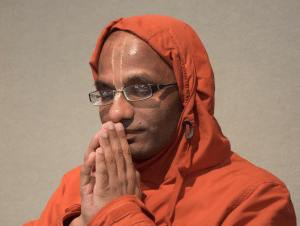 I felt as if the whole scene was surreal, a flashback to the times when Srila Prabhupada began it all single-handedly in a small storefront inLower East Side, New York. Here, all I had to do was just give a talk while a whole team did everything else. But Srila Prabhupada had to do it all himself. How incredibly difficult it must have been for him! I had spoken and written on Srila Prabhupada’s unbreakable, inconceivable determination, but contemplating it on the mission field of Australia took my appreciation and gratitude to a much higher level. The fact that many sincere people were taking to bhakti-yoga here down under was a spiritual wonder – a living miracle that had manifested as the fruition of the careful passing on of the bhakti legacy by generations of saintly teachers.
I felt as if the whole scene was surreal, a flashback to the times when Srila Prabhupada began it all single-handedly in a small storefront inLower East Side, New York. Here, all I had to do was just give a talk while a whole team did everything else. But Srila Prabhupada had to do it all himself. How incredibly difficult it must have been for him! I had spoken and written on Srila Prabhupada’s unbreakable, inconceivable determination, but contemplating it on the mission field of Australia took my appreciation and gratitude to a much higher level. The fact that many sincere people were taking to bhakti-yoga here down under was a spiritual wonder – a living miracle that had manifested as the fruition of the careful passing on of the bhakti legacy by generations of saintly teachers.
Sattvika Courtship
In between my many classes (I gave some 16 classes and 2 QA sessions), I met many devotees. On one of the days, the Temple Vice-President, Nanda Mandir Prabhu, told me that his spiritual master and one of the GBCs (Governing Body Commissioners) there, His Holiness Devamrita Maharaja, had a whole system for courting: If a devotee-couple desired to marry, they were asked to first go through a period of two-year courting with all meetings during the first year supervised by a chaperone. The system struck me as remarkably sattvika and just suited for curbing the rajas inherent in romance.
When I met Devamrita Maharaja later and appreciated the courtship system, he told me how it had been hugely successful in bringing stability and longevity to marriages among Western devotee couples. We had an absorbing discussion for one-and-half hours on various styles of writing and speaking for Western audiences. Maharaja also connected me with his team that is producing the captivatingly contemporary ENOUGH magazine to attract Westerners to Krishna.
Later, I contemplated further on the courtship system. I had written a few years ago that to resist our impulses, we all need to develop our own pause buttons – some customized set of actions that counter the pressure of our impulses and restore our capacity to think clearly. It struck me that this courtship system is an excellent example of a socially arranged pause button.
These thoughts were churning through my mind when I spoke one evening at a youth meeting on the topic, “Emotion Commotion Devotion: Nourishing our emotions in a culture of emotional exploitation” While addressing the question, “Which are better: love marriages or arranged marriages?” I pointed out that the nomenclature itself was biased – it implied that arranged marriages had no love in them, and that those who favored arranged marriages were against love. Someone biased the other way could well rephrase the question as: “Which are better: infatuation marriages or arranged marriages?” The point is that the foundation for a sustainable marriage cannot be the infatuation of “Love at first sight”; it has to be the commitment that enables one to continue loving after many sights. For millions of people for millennia, that commitment came from having their marriages arranged and blessed by elders.
In contrast, rajo-guna with its infatuation rivets our vision to our emotion, letting us see only those things that agree with the present emotion. Initially, rajo-guna makes one feel, “I can’t live without you.” But when inevitable differences and disagreements crop up, the same rajo-guna makes one feel, “I can’t live with you.” The pause button of the waiting period allows time for sattva-guna to return and broaden the uni-dimensional vision of rajo-guna. With this expanded vision, one can make a more mature decision about the relationship.
As the cultural values in India change and devotee-couples increasingly choose love marriages (I use this term for lack of a non-judgmental alternative), I feel that sociological improvisations such as a sattvika courting system will be needed in India – sooner rather than later.
Appreciation-without-infatuation
In our spiritual evolution, we all go through phases. Like most Indians, I had grown up with a deep-rooted Western infatuation. After I started practicing bhakti-yoga in my youth, I oscillated, like many other young Indian devotees, towards the opposite, indulging in blanket condemnation of the West. Whenever I look back at some of the articles about Western culture I wrote ten years ago, I periodically catch myself wincing at the sweeping generalizations.
Probably I needed nearly two decades of devotional purification and spiritual maturation to come to the balanced state of appreciation-without-infatuation and criticism-without-condemnation. During my visit to Australia, I could see much to appreciate. Meticulous organization of things was evident everywhere – from the arrangement for half-flush in washrooms to conserve water to the symmetrical positioning and systematic numbering of houses on both sides of the roads to the provision of ramps at all public places for people with special needs. I could only wish that if India could organize things even half as well, so many people – Indians included – could be saved from the negative first impression that prevents them from looking deeper for India’s spiritual wisdom. Indeed, many have been the Western minds who though fascinated by reading Indian wisdom-literature were dismayed on actually coming to India, bemoaning, “How could people so organized in their philosophical thinking be so disorganized in their practical living?”
The impressive material organization in Australia notwithstanding, I could discern signs of a pervasive inner emptiness. As Australian psychological and sociological surveys testify, emotions are often in chaos and relationships are frequently in a mess. When in my talks I quoted sociologists who reported the paradoxical finding, “People in the developing world have far more to be worried about than people in the developed world, yet people in the developed world are more worried than people in the developing world,” I could see many Western heads nodding. And when I quoted how immigrants from the developing world to the developed world tend to have higher stress levels after immigration, I could see many Indian heads nodding too.
Moving moments with devotees
By far the most encouraging aspect of the visit for me was getting to know the many devotees who were actively using the content from thespiritualscientist.com and gitadaily.com. Being able to replace the statistics of site visitors with the faces of intelligent devotees was enlivening and fulfilling – it made my online outreach more personal and reciprocal. Mehul Prabhu and his wife Bhavika Mataji who is a web-developer offered to make a subdomain answers.thespiritualscientist.com for newcomers. Amit Gupta Prabhu has made meticulous PowerPoint presentations on important points from many of my classes – powerpoints that could be used for making short audio-visual presentations. Gaurava Sharma had made an attractive video based on one of my answers and will be making videos for several of the best FAQs on the site. And coming at last to the best, Muralidhar P is a devotional dynamo. He envisioned the whole trip, organized the various programs and throughout kept me focused. With him by my side, I felt like a spendthrift player protected by a parsimonious manager.
Bhurijana Prabhu, who was in in Perth and who is the spiritual master of Aniruddha Prabhu, heard from him that I was in Melbourne and asked that I call him. We have met only twice, but both times he had shown such phenomenal empathy that within minutes our discussion had gone to great depths.
He generously shared his realizations about the challenges in being an introvert in a preaching movement and about balancing between writing and traveling-speaking. He reiterated his writing motto, an ancient Latin saying: Nulla Dies Sine Linea (Never a day without a line). That spirit has been the driving force for my writing daily at gitadaily.com. As all the issues we discussed spoke directly to my own challenges as a sadhaka, I felt myself blessed by our hour-long phone discussion.
For my relatives who I knew would be interested only in “Which places in Australia I had seen?” I had already prepared what I thought was a brilliant riposte: “I didn’t go to Australia to see Australia. I went there to show Krishna to Australia.” But thankfully, humility and honesty won the day in my heart: “After all, I am far from having seen Krishna myself, so who am I to show him to anyone? If others are able to get a glimpse of Krishna’s attractiveness through my talks, then that is Krishna’s mercy in reciprocation to their sincerity.” So I abandoned my self-righteous plan of not going to see any scenic places. On the last day of my visit, after I had completed all my classes and had some breathing room, I went along with the devotees’ suggestion to go for a walk to a nearby lake. And I found the walk relaxing – the beauty of the lake reminded me of the lake that I find most beautiful in Vrindavan, Kusum Sarovar.
My last interaction was with a select group of Western devotees from whom I wanted to learn more about the Western mind. As I heard from them about how they came to bhakti, I could better appreciate the massive conceptual and cultural barriers they had to scale. One Mataji told how the mantra lounge program was the only way she could have come to bhakti – if during her first days she had met anyone with “clay on the face,” she would never have even considered joining such a weird group. A Prabhu mentioned that his friends’ idea of spirituality had largely been aromatherapy. That people from such backgrounds had come to bhakti is testimony to the expertise of the devotees in presenting bhakti’s universality. That these devotees were striving to help others scale the same barriers spoke volumes to their dedication.
Rounding it up
The days passed in a blissful blur and when on the midnight of 8th July I returned to the Melbourne airport for my return flight to India, I couldn’t but share the sentiments of the devotees with me: it felt as if I had arrived at the place just a few days ago.
During my flight back, I wondered: So did I learn how to write for a Western audience? Yes, I certainly did – I learnt that I still have a lot to learn. As I contemplated further, I felt that the mind would be an excellent topic through which to present the wisdom of the bhakti tradition. Among all my talks, perhaps the most well-received were the two on the mind: “The mind is the TV and the thief” and “Catch the ventriloquist with intellectual and emotional energy.” Though the audience for these talks was mostly Indian and devotees at that, still I could sense that the same points could be presented with some adaptation for a Western audience. In fact, when I had spoken some of those points in my classes to Westerners, they had connected well with those points. In one of my talks I made the point that even those who consider the bhakti tradition’s depiction of the mind a conceptual model, not an ontological realty, can still reap benefits. People may or may not believe in the existence of God or the soul, but they all have to face with undeniable force and frequency the reality of something within that impels them towards self-defeating behavior. If they can get a coherent model of what that thing is and how they can deal with it – and the bhakti tradition offers both – then they would feel empowered and become more open to the other gifts of the tradition.
I hope and pray that I can mind my mind enough to write on the mind soon.
London Rathayatra 2015 (Album with photos)
See them here:…
→ Dandavats.com
Hare Krishna! Srila Prabhupada on Newsstands Now!
The famous…
→ Dandavats.com

Hare Krishna! Srila Prabhupada on Newsstands Now!
The famous Mantra Rock Dance Poster from 1967 is prominently displayed on page 52 of Newsweek’s Grateful Dead 50th Anniversary magazine on newsstands now. All glories to Srila Prabhupada!
Read the entire article here: http://www.dandavats.com/?p=17947
If science just uses pre-existing mechanisms how does that apply to computer codes and programs?
→ The Spiritual Scientist
Answer Podcast:
Download by “right-click and save content”
Does scripture have mathematical equation for relativity?
→ The Spiritual Scientist
Answer Podcast:
Download by “right-click and save content”
Can yoga be copyrighted?
→ The Spiritual Scientist
Answer Podcast:
Download by “right-click and save content”
Is yoga a cure-all?
→ The Spiritual Scientist
Answer Podcast:
Download by “right-click and save content”
Can there be something called Christian yoga?
→ The Spiritual Scientist
Answer Podcast:
Download by “right-click and save content”
Is yoga Hindu or not?
→ The Spiritual Scientist
Answer Podcast:
Download by “right-click and save content”
World Yoga Day – Let’s Go Beyond Political and Physical Posturing
→ The Spiritual Scientist
Talk Podcast:
Download by “right-click and save content”
Harinama and TV show in Chisinau, Moldova (Album with…
→ Dandavats.com

Harinama and TV show in Chisinau, Moldova (Album with photos)
Indradyumna Swami: As a build up to our festival this coming weekend in Chisinau, Moldova we did harinama on the streets of the capital in the morning. In the afternoon we were featured live on the most popular television talk show in the country. Over one million people watched as we explained the philosophy of Krsna consciousness and discussed our upcoming festival. We even cooked halavah in the studio as part of the program, much to the delight of the TV crew who enjoyed it immensely after the 90-minute show!
See them here: https://goo.gl/KAq3My
TOVP update: Kalash – Preparation Works has Begun! (Album with…
→ Dandavats.com

TOVP update: Kalash – Preparation Works has Begun! (Album with photos)
Sadbhuja Das: We are now at the final stage of the main dome construction. Preparation works has began for the Kalash and the Chakra!
Looking at this image, you can really see how big is the Kalash by comparing the proportions of the people and the Kalash. Standing at 277 feet (84.4 meters) from the ground, it gazes upon us in great splendor.
See them here: https://goo.gl/G8TJWf
Hare Krishna! Prime Minister Sri Narendra Modi meets winner of…
→ Dandavats.com

Hare Krishna! Prime Minister Sri Narendra Modi meets winner of Bhagavad Gita Champion League Conducted by ISKCON
Gita Champions League(GCL) is a Bhagvad Gita contest organized by ISKCON Chowpatty since last 4 years. This year 2015, the winner of the contest was Ms. Maryam Asif Siddiqui, aged 12 from Mira Road, Mumbai, Maharashtra. The President of India, Shri Narendra Modi meeting with Ms. Maryam Asif Siddiqui, winner of the GCL Competition 2015 organized by ISKCON Chowpatty along with her parents
Read the entire article here: http://www.dandavats.com/?p=17944
The Chaste Wife
→ Krishna Dharma
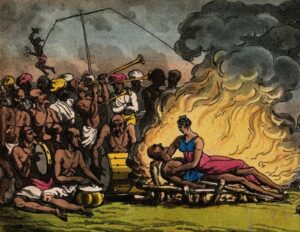 There was once a wicked man of the lower classes. He abandoned all holy rites and gave himself to sin. He had a young wife but also kept a prostitute in his house. The wife, wishing only to please him, served them both. She washed their feet and ate only the remnants of their food. Although the prostitute tried to prevent her she continued to serve that woman in every way, along with her husband. When they lay together in bed the wife would lie nearby on the bare ground. In this way for a long time she constantly served her husband and the courtesan, wading through the ocean of misery.
There was once a wicked man of the lower classes. He abandoned all holy rites and gave himself to sin. He had a young wife but also kept a prostitute in his house. The wife, wishing only to please him, served them both. She washed their feet and ate only the remnants of their food. Although the prostitute tried to prevent her she continued to serve that woman in every way, along with her husband. When they lay together in bed the wife would lie nearby on the bare ground. In this way for a long time she constantly served her husband and the courtesan, wading through the ocean of misery.
It came to pass that the husband, due to eating bad food, contracted a disease that caused weeping sores all over his body. He was extremely distressed day and night. The prostitute, taking everything of value from the house, left one night and went to another man. The husband became ashamed. He said to his wife, ‘Great has been my sin. I have acted cruelly and sported with a prostitute even in front of you. What will be my fate now? The Vedas say that a man who neglects a chaste and faithful wife will suffer terribly through the course of fifteen lifetimes.’
The man was consumed by remorse and he begged his wife’s forgiveness, praising her fortitude and chastity. The wife said, ‘Do not say so. My suffering has come about simply due to my own past acts. I do not blame you or anyone else. This has been the fruit of my own sins.’
In this and other ways she consoled her husband. She brought money from her father and other relatives and continued to nurse him. She assiduously cleaned his body, washing away the pus with turmeric water and cleansing his anus and private parts, which had become cancerous. She fanned him with peacock feathers and slept little during the day or night. Distressed by his misery she felt as if the world was ablaze on all sides.
That faultless lady prayed, ‘May the gods and forefathers hear me, may Goddess Earth favour me, please release my husband from his pain. I shall make all offerings to you. I shall fast and place my body on the points of sharp thorns. I shall give up cooked food and sweets, enduring any and all difficulty. Let my husband live for a hundred years free from ailment.’
But her husband’s illness deteriorated. She still served him menially, feeding him by her own hand. One day his life airs suddenly passed off and his jaws clamped shut as she fed him, biting off her finger. Not minding this, but seeing that he had died, the lady grieved for some time. She then sold off her jewellery and bought a heap of fuel. Building a great funeral pyre she poured oil all over it and placed her husband’s body on it. She then climbed onto the pyre and joined with her husband, placing her face next to his, her heart by his heart and her arms around him. Dragging a flame to the pyre with her foot she set it alight. As the fire blazed up she cast off her body and rose to the heavens, taking her husband with her.
(This story is from ‘Two Vedic Tales’ by Krishna Dharma.)
Preaching in Boise, Idaho (2015) (Album with 108 photos)
Deena…
→ Dandavats.com

Preaching in Boise, Idaho (2015) (Album with 108 photos)
Deena Bandhu Das: More pics of our tour: Preaching in Boise, ID and meeting my old friend Kamalananda whom I haven’t seen for 40 years after making him a devotee in Portland. He used to make the buses for Radha Damodar TSKP, now he works around the Boise Mandir!
See them here: https://goo.gl/SWbW5z
Is Purusottama-masa better than Karttika?
→ SivaramaSwami.com
The post Is Purusottama-masa better than Karttika? appeared first on SivaramaSwami.com.
Daily Darshan – June 18th, 2015
→ Mayapur.com
The post Daily Darshan – June 18th, 2015 appeared first on Mayapur.com.







